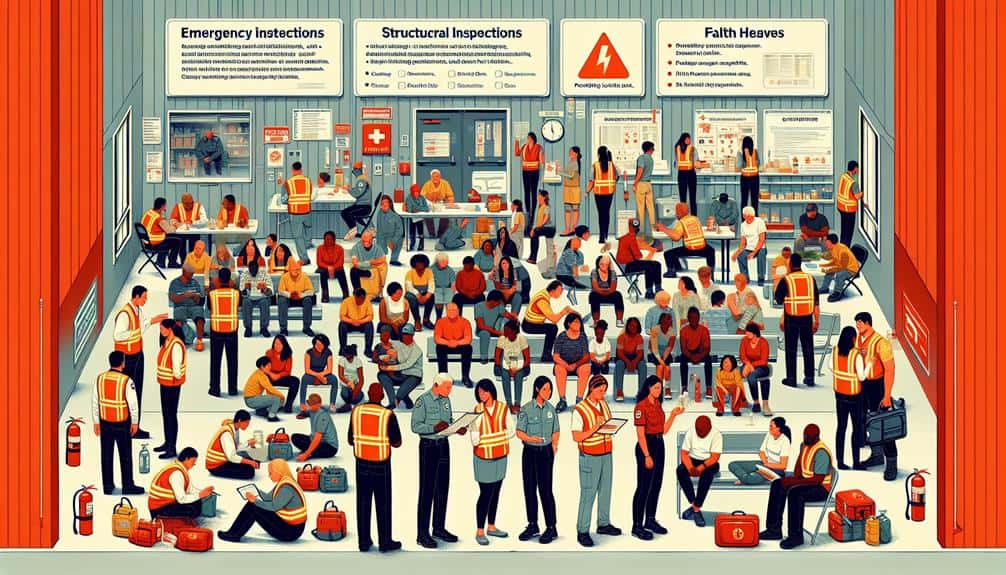When coordinating shelter placement for displaced storm survivors, we swiftly evaluate immediate needs and identify available shelter locations. Partnering closely with local authorities, we guarantee safe, timely placements and effective resource distribution. Our efforts include mobilizing community volunteers, streamlining transportation logistics for essentials, and adhering to strict shelter safety standards. Clear communication keeps survivors informed and supported, while continuous monitoring allows us to adapt plans quickly based on evolving circumstances. By staying organized and proactive, we address the vital needs of displaced individuals efficiently. To explore deeper insights and strategies, there's more essential information ahead.
Key Points
- Conduct rapid assessments of living conditions and shelter capacities to identify immediate needs.
- Coordinate with local authorities and community centers for the identification and setup of safe shelter locations.
- Utilize GPS technology for monitoring and optimizing transportation logistics for swift movement to shelters.
- Engage local volunteers to assist with logistics, check-ins, and supply management at shelters.
Assessing Immediate Shelter Needs
Understanding the immediate shelter needs of storm survivors starts with a rapid assessment of their current living conditions and available resources. First and foremost, we need to assess the shelter capacity in affected areas. This involves determining how many individuals each facility can accommodate and what essential resources, such as food, water, and medical supplies, are on hand. By knowing the shelter capacity, we can better allocate immediate assistance and support to those who need it most.
To effectively evaluate these needs, we should communicate directly with survivors and local authorities. Asking specific questions about their current situation helps us collect accurate data. This includes understanding if they're currently in temporary shelters, residing with relatives, or if they've no shelter at all.
Our immediate assistance efforts must also consider special needs populations, such as the elderly or those with disabilities, who might require additional support. By identifying these critical needs early, we can guarantee a more effective and efficient response.
Ultimately, our goal is to provide storm survivors with the support they need to regain their sense of freedom and security as quickly as possible. With organized, concise assessments, we can make well-informed decisions that optimize our resources.
Identifying Available Shelter Locations
To identify available shelter locations, we need to assess local community centers, temporary housing facilities, and coordinate with emergency response teams.
We'll prioritize sites that can quickly accommodate a large number of people.
Effective communication with these facilities guarantees that we can provide safe and immediate shelter for displaced storm survivors.
Local Community Centers
Local community centers play a pivotal role in identifying available shelter locations for displaced storm survivors. These centers are often the first point of contact for individuals in need, making community outreach essential. By engaging with local residents, we can quickly gather information on available spaces and guarantee effective resource allocation.
Community centers help streamline the process of finding shelters by providing:
- Centralized Information Hubs: We maintain updated lists of available shelters, guaranteeing rapid dissemination of information.
- Coordination with Local Authorities: Partnering with police, fire departments, and municipal offices helps us identify safe locations.
- Volunteer Mobilization: Our community outreach efforts recruit local volunteers who assist in setting up and maintaining temporary shelters.
Temporary Housing Facilities
Identifying accessible shelter locations involves a proactive approach to guarantee displaced storm survivors have safe and immediate housing options.
First, we need to assess the shelter capacity of local facilities. This means checking how many people each location can accommodate without compromising safety and comfort.
We start by compiling a list of potential housing resources, including schools, churches, and community centers. These places often have the necessary infrastructure to provide temporary shelter. By contacting administrators and local authorities, we can quickly determine which sites are available and ready to be converted into emergency shelters.
Next, evaluating the condition of these facilities is essential. We must make sure they meet basic standards, such as sanitation, accessibility, and security. This step helps us avoid situations where survivors are placed in inadequate or unsafe conditions.
To streamline this process, we create a centralized database that lists all available shelter locations, their capacity, and their current status. This enables us to make informed decisions and react swiftly in the face of an emergency.
Emergency Response Coordination
Effective emergency response coordination starts with swiftly pinpointing available shelter locations. When a storm hits, we need to act fast to make sure displaced survivors have a safe place to go. This involves a meticulous process of resource allocation and shelter coordination, which are essential for efficient disaster relief.
First, we identify available shelters by tapping into a pre-established database of potential locations. These could be community centers, schools, or other public buildings that can be quickly repurposed. Next, we assess the capacity and suitability of each location to guarantee they meet the immediate needs of the displaced population.
Real-time Data Monitoring: We use advanced technology to track available shelter spaces in real time.
Community Partnerships: Collaborating with local organizations helps us identify unconventional but viable shelter spots.
Rapid Assessments: Swift evaluations of potential shelters help us determine their readiness for occupancy.
Resource Allocation: Efficiently distributing resources like food, water, and medical supplies is key to making these shelters operational quickly.
Coordinating With Local Authorities

We often collaborate closely with local authorities to ensure that displaced storm survivors receive timely and appropriate shelter placements. Our partnership with government agencies and community leaders is essential for effective resource allocation. By pooling our efforts, we can guarantee that every available resource is utilized efficiently, enhancing our overall effectiveness. Government collaboration allows us to tap into a wider network of facilities and services, which is important during times of crisis.
Community engagement plays a significant role in our operations. Local authorities often have a deeper understanding of the community's needs and can provide invaluable insights. This grassroots knowledge helps us tailor our shelter placements to better serve those affected. Additionally, engaging with the community fosters a sense of solidarity and collective action, which is crucial for overcoming the challenges posed by natural disasters.
Volunteer coordination is another important aspect. Local authorities help us mobilize volunteers, ensuring we've the manpower necessary to set up and manage shelters quickly. Coordinating with local volunteers not only speeds up the process but also empowers the community, giving individuals a sense of agency in their own recovery. Together, these efforts create a robust, responsive system for shelter placement.
Streamlining Transportation Logistics
Having established strong partnerships with local authorities, we now focus on streamlining transportation logistics to guarantee displaced storm survivors reach their designated shelters swiftly and safely. Effective transportation coordination is essential, not just for moving people, but also for delivering emergency supplies to areas in need.
To achieve this, we've developed robust logistics management and communication strategies that ensure smooth operations. Here's how we're doing it:
- Real-time tracking: By using GPS technology, we can monitor the movement of buses and trucks, ensuring they follow the most efficient routes and avoid areas still impacted by the storm.
- Centralized dispatch: A centralized communication hub coordinates all transportation efforts, allowing for quick rerouting and adjustments as situations on the ground change.
- Resource allocation: We prioritize the distribution of emergency supplies based on immediate needs, ensuring shelters have the essentials like food, water, and medical kits.
These measures empower us to act swiftly and effectively, providing a streamlined process that upholds the dignity and freedom of storm survivors during these challenging times.
Ensuring Shelter Safety Standards

Ensuring the shelters meet safety standards means addressing both structural integrity and the health and well-being of the occupants. First, we conduct thorough safety inspections to identify any potential hazards. These inspections cover the building's foundation, roofing, electrical systems, and fire safety measures. We can't overlook any detail because each element plays an essential role in keeping everyone safe.
Next, we implement emergency protocols to prepare for any unforeseen incidents. This includes clear evacuation routes, accessible exits, and designated areas for medical assistance. Our protocols also cover coordination with local emergency services to guarantee rapid response times.
Moreover, we focus on the health and well-being of the occupants. This involves ensuring proper ventilation, clean water supply, and adequate sanitation facilities. We also provide mental health support and medical care to address the emotional and physical needs of the survivors.
Communicating With Displaced Individuals
Effective communication with displaced individuals is vital to provide timely information and support. We need to guarantee that our communication strategies are clear, empathetic, and actionable. By doing so, we can offer emotional support and guide them through the process of finding shelter.
Our communication strategies should include:
- Proactive updates: Regularly inform individuals about shelter availability, resource distribution, and any changes to plans.
- Multi-channel outreach: Use various platforms such as social media, SMS, and local radio to reach a broader audience.
- Supportive counseling: Offer counseling services to help individuals cope with the emotional impact of displacement.
By implementing these strategies, we can guarantee that displaced individuals feel heard and supported. Emotional support is pivotal during such tumultuous times, and our approach must reflect compassion and understanding. Supportive counseling can provide a safe space for individuals to express their fears and anxieties, while effective resource distribution ensures they've access to essentials.
Let's remember, communication isn't just about conveying information; it's about building trust and providing a sense of stability amidst chaos. We must be diligent, compassionate, and responsive to the needs of those who are displaced.
Monitoring and Adapting Shelter Plans

To guarantee the safety and well-being of displaced storm survivors, we must continuously monitor and adapt our shelter plans based on evolving needs and circumstances. A dynamic approach ensures that we can respond swiftly to changes and provide the best possible care.
First, tracking resources is essential. We need to keep a close eye on the availability of food, water, medical supplies, and bedding. Regular inventory checks help us avoid shortages and secure that no one goes without essential items. By maintaining updated records, we can swiftly redistribute resources to where they're most needed.
Next, adjusting capacity is crucial for effective shelter management. As new survivors arrive, we may need to increase our shelter's capacity. This could mean setting up additional sleeping areas or expanding common spaces to accommodate more people.
Conversely, if some survivors move on to more permanent housing, we should reduce capacity to avoid overcrowding and ensure comfort for everyone.
Frequently Asked Questions
How Can Individuals Donate to Support Shelter Efforts for Storm Survivors?
Did you know 80% of donations come from individuals? We can contribute through various donation methods or participate in fundraising events. Let's unite to support shelter efforts and make sure everyone has a safe place.
Are There Volunteer Opportunities Available for Helping Displaced Storm Survivors?
Yes, there are volunteer opportunities available! We can engage with our community by helping displaced storm survivors. Volunteer training guarantees we're prepared to assist effectively. Let's contribute and make a difference together.
What Mental Health Resources Are Provided at Shelters for Storm Survivors?
Imagine a lighthouse guiding ships through a storm; shelters offer trauma counseling and emotional support to help survivors navigate their turbulent emotions. We've got trained professionals on-site to guarantee everyone gets the care they need.
How Are Dietary Restrictions and Allergies Managed in Emergency Shelters?
We guarantee food accommodations by providing diverse meal options and clearly labeling allergens. Our team prioritizes allergy management, working closely with medical staff to address individual needs and ensure everyone's dietary restrictions are respected in emergency shelters.
How Long Are Displaced Individuals Typically Housed in Temporary Shelters?
Typically, individuals stay in temporary shelters for an average duration of a few weeks. We make sure they receive necessary support services, helping them regain independence and move to permanent housing as swiftly as possible.


